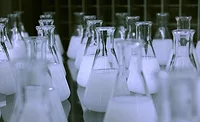Selamat Datang Ke Malaysia - Welcome to Malaysia

According to Wilhelm Klammer, product manager, BYK-Chemie GmbH, the “Asian coatings and ink manufacturing market is of extreme importance to BYK-Chemie, as one third of our business is obtained from the Asia-Pacific area. Therefore the Asia Pacific Coatings Show offers an excellent opportunity to exchange information with existing and prospective customers, and is also the ideal event at which to introduce new products to the market.”
Organized by DMG Business Media, the show was supported by the Malaysian Paint Manufacturers Association (MPMA). The MPMA also endorsed the two-day conference titled “Waterborne High-Solids, Radcure and Powder Coatings” that ran concurrent to the exhibition. Attendees for the conference were primarily from the Pacific Rim countries.
There were over 130 exhibitors, which presented a rather nice size for a show in this area for over 3,000 registered attendees. The show was well represented by equipment and raw-material suppliers to the industry. Several exhibitors said that they like a show of this size compared to some of the larger events because they feel they have more of a presence and are not “swallowed up,” as often happens in very large-scale events.
Wolfgang Habel, General Commercial Manager EFKA Additives, said he considers the Far East one of the most important markets, and this venue as a major event where an exchange of information between the market and its suppliers can take place. EFKA is a major additives producer for the paint, printing ink and plastics industries.
Several new technologies debuted at the show. Merck, one of the leading pigment producers for automotive and industrial coatings, showcased its new effect pigments. One type, based on silicone dioxide flakes, gives the multitude of colors typical of effect pigments as well as the flowing and streaming of color sometimes clearly and sometimes subtly visible and varying with the angle of viewing. Another effect pigment, based on aluminum oxide flakes, demonstrates a strong glitter effect with a clearly visible gleaming property. Automotive coating applications in particular will find this rather exciting.
Thomas Swan & Co. Ltd., based in the United Kingdom, chose this event to introduce a new product for powder coatings formulators that provides a “one-shot” solution to achieving consistent, controllable results across a wide range of gloss levels. Much of the current technology for achieving a matte finish requires a process of dry blending, using two powder coatings, which tend to give unpredictable results and has additional cost in terms of process time and materials wastage. Swan’s Coating Product Manager Andrew Saunders says they are “delighted to announce this achievement as formulators have needed this product for a long time. This matting agent is highly effective and works across the color range — including white and light colors.” Weathering trials in the United Kingdom and Florida, plus accelerated QUV laboratory tests, have proven the durability of the finish.
Peter Yang, marketing manager, Coatings Korea Branch, and Patrick Lim Kah Hock, market manager, Singapore Branch, both from Johnson Polymer, were very optimistic but cautious for coatings in Asia Pacific, as the economy is up for all of southeast Asia with the exception of Indonesia, where political unrest is responsible for the instability. They say that while all the area is recovering very nicely from the 1997 economic crisis, China and India are showing major growth. Technically, the biggest growth area in Asia is powder; the second biggest growth area is waterborne conversion. For powder, it is representative of both new startup companies as well as conversion from other technologies. The Asian countries for the most part have no regulatory environment to contend with. The governments have not issued mandates such as those in existence in North America and Europe. But, for the most part, this does not seem to be a problem because the manufacturers are either global companies that are using compliant technology or regional ones that rely primarily on global raw material suppliers that are also in compliance in other parts of the world.

Johan Bieleman, market development manager, Condea Servo, echoed much of the same comments — after the ‘97 crises there is clearly an improvement in the economy in Malaysia, China, Taiwan, Thailand and most of the Asia Pacific region. Industrial growth is being noted in all areas including solventborne. They have not seen a decline in solventborne. Interest is also very good for high-solids coatings; in fact, he noted that there is more interest in high solids than in waterborne.
Johan also noted that the margins are not there for raw material suppliers. Manufacturers are trying to reduce cost. The biggest manufacturers in Southeast Asia are ICI and some of the regionals like Pacific Paints and Nippon. There are global pricing agreements and policies in place and so the raw material suppliers need a global presence to survive.
Christina Waardal, managing director of Waardals (Norway) said she was pleased with the attendance at the show and the serious interest being shown by attendees. Waardals is a manufacturer of anticorrosive and flame retardant pigments and has been in existence for over 50 years. Waardal indicated that, while the market for anticorrosive pigments is stable, it is always very difficult to introduce new products due to the very long testing periods required. From their perspective, solventborne coatings are still alive and well. Waterborne is still a challenge when it comes to anticorrosives. The major difficulties encountered today are not technical but rather the consolidation that has occurred within the industry. The number of customers has decreased considerably and, because of long-term contracts, increased competition and decreasing margins, coatings is a challenging and sometimes difficult business.

The global raw material and manufacturing supplier community was well represented at this event. Based on input from exhibitors it certainly seemed that all were quite pleased with the interest and leads being generated. At many times the booth areas were very crowded and so were the aisles. My own observations certainly confirm the comments that I heard from the people I spoke with. Also, it is very apparent that the construction industry is very much alive in both Singapore and Malaysia. Construction is occurring in both countries and it seems that each facility is bigger and more attractive than the last one. The architecture in both countries is extraordinary and highly colorful.
As a personal note I can say Malaysia truly is a land of friendliness and hospitality.
The next Asia Pacific Coatings Show is scheduled for June 27–28, 2001, in Bangkok, Thailand. For more information, contact DMG World Media, Queensway House, 2 Queensway, Redhill, Surrey RH1 1QS England; fax +44/1737.855469; e-mail jmalcolm-coe@dmg.co.uk; or visit www.dmg.co.uk.
Sidebar: A Snapshot of Malaysia
Malaysia has a population of 22 million people representing a blend of cultures where Malay, Chinese, Indian and others live together in harmony. Malaysia is divided by the South China Sea into two regions with peninsular Malaysia sharing borders with Thailand and Singapore. The capital is Kuala Lumpur, which started as a large tin trading settlement. It is now an impressive city with many skyscrapers and a well-developed transportation system. Kuala Lumpur serves as the base for many international companies that operate in the area. In Malaysia one finds the tallest building in the world (Twin Towers), rainforests, palm oil plantations and designer golf courses.Due to the regional economic meltdown in 1997, the economy slipped off the track of an 8% GDP growth for eight consecutive years. A growth of 4–5% is forecast for 2000. The petroleum industry tops the list of contributors to the GDP. The manufacturing sector is export oriented. Thailand has overtaken Malaysia as the world’s major rubber producer; however, palm oil, of which Malaysia is the world’s largest producer, is now a more important export product. Malaysia is a significant exporter of oil and natural gas. Oil reserves are offshore. Malaysia accounts for nearly half of the world’s timber exports.
The country’s national car is the Proton, which is manufactured in Malaysia. Agriculture is a big industry and consists primarily of palm oil, rubber and latex, pepper and cocoa beans and orchids. One of Malaysia’s biggest strengths is electronics: it is the world’s biggest producer of disk drives.
Links
Looking for a reprint of this article?
From high-res PDFs to custom plaques, order your copy today!






